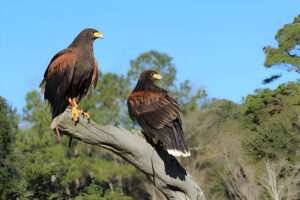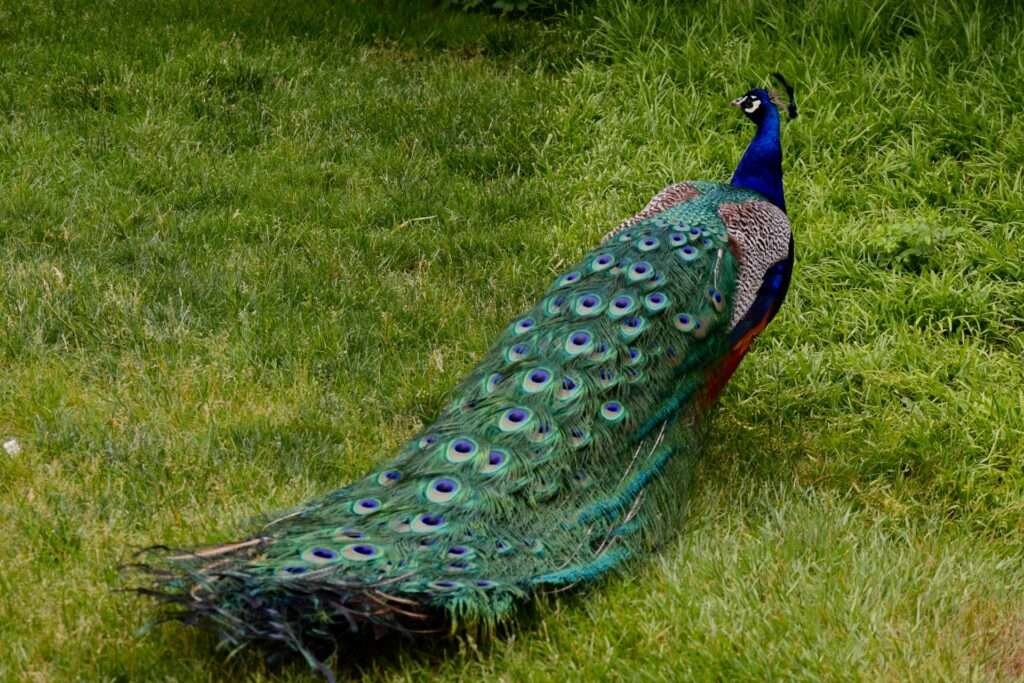Texas is home to about 17 species of hawks, including the widespread Red-tailed Hawk. These birds of prey are known for their keen hunting skills and can be spotted throughout the state.
Hawks are a fascination among birdwatchers and wildlife enthusiasts in Texas. With a diverse range of habitats, from the coastal plains to the hill country, Texas offers a favourable environment for these raptors to thrive. Species like the Cooper’s Hawk, Sharp-shinned Hawk, and Harris’s Hawk enhance the biodiversity of the Texan skies.
Birders often seek the thrill of witnessing hawks in their natural settings, soaring gracefully or perched high on a lookout. Their presence contributes significantly to maintaining the ecological balance by controlling rodent and insect populations. Texas provides ample opportunity throughout the year for anyone interested in observing these magnificent creatures, with sightings varying by season and location.
Types Of Hawks
The skies of Texas are home to several remarkable species of hawks. These raptors are masters of the air, each with unique traits and behaviours. Identifying the different types of hawks in Texas is exciting and enlightening for birdwatchers and nature enthusiasts alike. Let’s swoop into the world of these majestic birds.
Red-tailed Hawk
One of the most common hawks across North America, the Red-Tailed Hawk, soars high in Texas skies. With its distinctive reddish-brown tail, this powerful raptor is easily recognizable. It often perches atop poles and trees, keenly observing the ground for prey. The Red-Tailed Hawk has an impressive wingspan and a screeching call that captures the essence of the wild.
| Feature | Description |
|---|---|
| Size | 18 to 26 inches |
| Wingspan | 45 to 52 inches |
| Diet | Small mammals, birds, reptiles |
Cooper’s Hawk
The Cooper’s Hawk is a skilful flier. It darts through dense woodlands with astonishing agility. This hawk is medium-sized with a long, banded tail and rounded wings. Cooper’s Hawks hunt smaller birds, making backyard bird feeders their unexpected hunting grounds. Their presence is a sign of a thriving ecosystem.
- Stealthy hunter in wooded areas
- Can be seen chasing birds with great speed
- Nests in trees often close to the trunk
A Guide to Hawk Identification

Swainson’s Hawk
Swainson’s Hawk, a seasonal visitor, takes to the Texas skies during migration. These hawks prefer open areas like grasslands and fields. Swainson’s Hawk is known for its extreme migrations, travelling thousands of miles to South America for winter. Catch a glimpse of these travellers during spring or fall as they ride the warm air currents called thermals.
- Often seen in groups during migration
- Mainly feed on insects and small mammals
- Known for their distinctive flight pattern, soaring in circles
Habitat And Distribution
The vast state of Texas serves as an astonishing backdrop for the diverse species of hawks that call it home. Spanning through prairies, deserts, forests, and coastal areas, Texas provides an extensive array of habitats for these majestic birds of prey. Understanding where hawks thrive in Texas reveals the intricate balance of nature and the importance of conservation efforts.
Native Habitat
Hawks in Texas enjoy a variety of native habitats. Red-tailed hawks soar above open fields, while Cooper’s hawks sneak through dense woodlands. The state’s geography caters to different hawk species, each carving out a niche in environments well-suited to their hunting and nesting needs.
- Coastal Wetlands: Home to diverse fisheries, prime for Ospreys.
- Grasslands: Perfect for Ferruginous hawks to scan for prey.
- Wooded Canyons: Offering refuge for Sharp-shinned hawks.
Migration Patterns
Migration is a pivotal aspect in the lives of many Texas hawk species. As seasons change, food availability shifts, prompting hawks to travel. Swainson’s hawks are famed for their long-journey feats, covering vast distances to South America.
| Hawk Species | Spring Migration | Fall Migration |
|---|---|---|
| Swainson’s Hawk | February to April | August to October |
| Broad-winged Hawk | March to May | September to November |
Not all hawks migrate. Red-shouldered hawks and Harris’s hawks regularly stay within Texas year-round, capitalizing on the state’s abundant resources.
Physical Characteristics
The skies of Texas are home to a variety of majestic hawks. Size, colouration, and the features of their beaks and talons distinguish these powerful raptors. Let’s explore the distinctive traits that make these birds of prey stand out.
Size And Weight
Hawks in Texas come in several sizes. Smaller hawks like the Sharp-shinned Hawk measure about 10 to 14 inches in length. Larger species, such as the Red-tailed Hawk, can boast a wingspan reaching 56 inches. The weight of these birds can range from as light as 4 ounces for the tiniest members up to around 3 pounds for the heftier hawks.
Colouration
The colouration of Texas hawks is varied and breathtaking. Many display a blend of brown, white, and grey shades across their plumage. The Red-tailed Hawk, for example, is known for its distinctive rust-coloured tail, which stands out against its otherwise earthy tones. These colours add to their beauty and effectively camouflage while hunting in their natural habitat.
Beak And Talons
The beaks and talons of hawks are built for hunting. Their hooked beaks are perfectly shaped for tearing flesh. When discussing talons, one cannot ignore their incredible strength and sharpness. These raptors grasp their prey with unyielding grip strength, ensuring that escape from their target is nearly impossible. This formidable combination of beak and talons makes them efficient predators of the skies.
Hunting And Feeding
The skies of Texas are home to various hawk species. These birds of prey exhibit remarkable hunting skills. Their hunting and feeding strategies are a spectacle of nature. Let’s delve into their world and discover how hawks in Texas sustain themselves.
Hunting Techniques
Texas hawks deploy diverse hunting techniques. Some soar high, using keen eyes to spot movements below. Others prefer a surprise attack, diving swiftly to capture their prey.
- Soaring and swooping: Hawks use thermal currents to rise without flapping wings.
- Perch and pounce: Perched on branches, they wait patiently before pouncing on an unsuspecting victim.
- Ground hunting: Some species walk on the ground, seeking insects and small animals.
Prey Selection
Prey selection is crucial for hawks, who eat mainly small mammals such as mice and voles.
| Prey Type | Common Examples |
|---|---|
| Mammals | Mice, Rabbits, Squirrels |
| Birds | Smaller songbirds, Pigeons |
| Reptiles & Amphibians | Snakes, Frogs |
| Insects | Grasshoppers, Beetles |
Insects and other small creatures also form part of their diet. This diversity ensures hawks adapt to different environments.
Behavior And Life Cycle
Ever marvel at the keen-eyed hawks soaring across the Texas sky?
The behaviour and life cycle of these birds is a spectacle.
Texas provides a haven for these majestic creatures.
Breeding And Nesting
Hawks in Texas engage in fascinating breeding rituals.
They pair for life, reinforcing bonds annually.
Nesting is a critical period, starting in early spring.
- Nest: Typically on high trees or cliffs.
- Materials: Sticks and vegetation form the base.
- Clutch Size: Usually 1-5 eggs.
- Incubation: Both parents share duties.
- Hatchlings: Care extends for weeks post-hatching.
Territorialism
The hawks fiercely defend their space.
Summer sees increased territorial behaviour.
They use impressive aerial displays to deter intruders.
| Behaviour | Purpose |
|---|---|
| Circling Territory | Monitoring Area |
| Screeching Calls | Warning Signal |
| Diving at Threats | Physical Deterrence |
A hatchling’s first flight claims their independence.
Young hawks learn to establish territories early on.
Conservation And Threats
Hawks are a prominent feature in the Texas skies. These birds of prey play a crucial role in the ecosystem, yet they face multiple threats. Here, we explore the conservation status and key challenges confronting hawks in Texas. We aim to spread awareness and encourage action to safeguard these majestic creatures.
Conservation Status
The conservation status of hawks varies. Data shows some species flourish while others struggle. Legal protection, conservation programs, and public education are vital. They help maintain stable populations. The Migratory Bird Treaty Act and local regulations provide a safety net for these birds.
Threats To Hawks
Hawks confront several dangers, including habitat loss, pollution, and human interference. Below, we delve into these issues to understand their impact on hawk populations in Texas.
Human Expansion
Urban sprawl eats into natural habitats, causing hawks to lose hunting grounds and nesting sites, which puts pressure on their ability to thrive.
Pesticides and Rodenticides
Chemicals used to control pests can poison hawks. These birds ingest toxins when they consume contaminated prey, reducing their survival rates.
Power Lines and Wind Turbines
Collisions with man-made structures are a constant hazard. They cause injuries or death, impacting hawk numbers negatively.
Illegal Shooting
Despite legal protection, some hawks are victims of unlawful shooting. Education about the importance of these birds is crucial to preventing such actions.
Climate Change
- Altered landscapes affect prey availability.
- Extreme weather events disrupt breeding patterns.
- Shifts in migration routes lead to additional challenges.
Awareness and proactive conservation efforts can help mitigate these threats. Hawks play an essential role in the biodiversity of Texas. It’s up to us to ensure their protection for generations to come.
Human Interaction And Importance
Texans share their vast lands with a remarkable group of birds: hawks. These birds of prey play a critical part in the ecosystem and feel the effects of human activity. Understanding these factors is key to protecting these majestic creatures.
Role In Ecosystem
Hawks serve as natural controllers of rodent and insect populations. Their presence helps maintain a balanced food chain. This role is critical for healthy natural environments.
- Predation: Hawks keep prey numbers in check.
- Scavenging: They clean the environment by consuming carrion.
- Indicators: Changes in hawk populations reflect local ecosystem health.
Impacts Of Human Activity
Humans have both positive and negative impacts on hawks in Texas. Urbanization, pollution, and agriculture pose threats. Yet, conservation efforts are improving hawk survival rates.
| Human Activity | Impact on Hawks |
|---|---|
| Habitat Loss | Reduces available nesting sites |
| Pesticides | Can poison hawks and their prey |
| Conservation Programs | Enhance protection and breeding success |
| Eco-tourism | Promotes awareness and appreciation |
Frequently Asked Questions
What Attracts Hawks To Your Yard?
Hawks are drawn to yards with abundant prey, such as small birds, rodents, and insects. Bird feeders and water features also attract these predators. Tree-lined landscapes provide perches for hunting and resting.
What Is The Grey Bird Of Prey In Texas?
The grey bird of prey commonly found in Texas is the Gray Hawk.
Are Hawks Good To Have Around?
Hawks control rodent and insect populations, making them beneficial for maintaining ecological balance and supporting healthy ecosystems. Their presence can also indicate environmental quality.
What Is The Most Common Hawk In Texas?
The Red-tailed Hawk is the most common in Texas, frequently spotted in various habitats across the state.
Conclusion
Exploring the skies of Texas unveils the majestic presence of hawks. These raptors embody the wild spirit of the Lone Star State. Whether you’re an avid birdwatcher or enjoy nature’s wonders, the hawks of Texas offer an enthralling spectacle.




